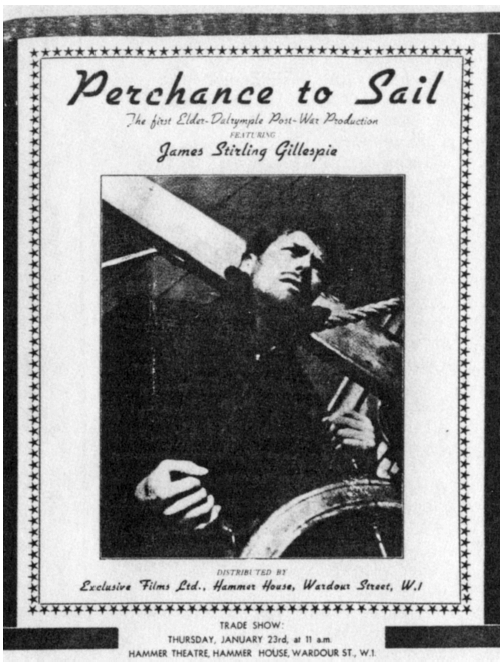
In the early days of film production, short subjects were, along with cartoons and newsreels, an important part of “going to the movies.” The company produced over seventy-five of these featurettes from 1935 to 1961 in both black and white and in color. A variety of subjects were covered, including musicals, instructionals, travelogues, and even fiction. Some of the following entries are covered at length because of their subject matter or participants. This listing may be incomplete.

Hammer’s scenic cruise through the war-ravaged countries of Eastern Europe.
1935 Polly’s Two Fathers (DIR: George Mozart)
1936 Musical Merrytone No. 1 (DIR: Will Hammer)
1945 Old Father Thames (DIR: Hal Wilson, Ben R. Hart)
The Peke Speaks
1946 Pekes Sold a Pop
Bred to Stay (DIR: A.A. Housset)
Candy’s Calendar (DIR: Horace Shepherd)
Cornish Holiday (DIR: Horace Shepherd)
Crime Reporter (DIR: Ben R. Hart)
An Englishman’s Home (DIR: John Miller)
It’s a Dog’s Life (DIR: Eric Leslie)
Perchance to Sail (DIR: J. Blake Dalrymple)
Skiffy Goes to Sea (DIR: Harry May)
Tiny Wings
We Do Believe in Ghosts (DIR: Walter West)
1947 Birthplace of Fame
Life Is Nothing Without Music (DIR: Horace Shepherd)
Material Evidence (DIR: Darrell Catling)
Paddy’s Milestone (DIR: J. Blake Dalrymple)
What the Stars Foretell (DIR: Tommy Tomlinson)
1948 The End of the Bridge (DIR: Richard Fisher)
Highland Story
Emerald Isle
Tale of a City (DIR: Richard Fisher)
1950 Queer Fish
Monkey Manners
1951 Village of Bray
1952 Call of the Land (DIR: Richard Fisher/ Color)
Giselle (DIR: Henry Caldwell)
Made for Laughs (Extracts from silent comedies)
River Ships (DIR: Peter Bryan)
1953 A Day in the Country (Filmed in 3-D)
Between Two Frontiers
Cathedral City
Sky Traders (DIR: Peter Bryan)
Valley of Peace
The World’s Smallest Country
1954 Denis Compton
Holiday on Skis
The Mirror and Markheim (DIR: John Lamont)
Polo
1955 Archery
A Body Like Mine
Cyril Stapleton and the Show Band (DIR: Michael Carreras/Color/Scope)
Dick Turpin—Highwayman (DIR: David Paltenghi)
Eric Winstone’s Stagecoach (DIR: Michael Carreras/Color/Scope)
Just for You (DIR: Michael Carreras/ Color/Scope)
A Man on the Beach (DIR: Joseph Losey/ Color)
Parade of the Bands (DIR: Michael Carreras/Color)
The Right Person (DIR: Peter Coles/ Color/Scope)
Setting the Pace
1956 Belles on Her Toes
Copenhagen (DIR: Michael Carreras/ Color/Scope)
History Repeats Itself
The Magic Carpet (DIR: Patrick Young)
Pleasure Hunt (DIR: Patrick Young/Color)
1957 Danger List (DIR: Leslie Arliss)
Dangerous Drugs
Sunshine Holiday
Yoga and You
Keeping Fit with Yoga
Yoga and the Average Man
Italian Holiday
Seven Wonders of the World
Day of Grace (DIR: Francis Searle)
The Edmundo Ros Half-Hour (DIR: Michael Carreras/Color/Scope)
Enchanted Island
Man with a Dog (DIR: Leslie Arliss)
1958 Blue Highway (DIR: Patrick Young)
Cathay Pacific (DIR: Patrick Young)
Clean Sweep (DIR: Maclean Rogers)
Riviera Express (DIR: Patrick Young)
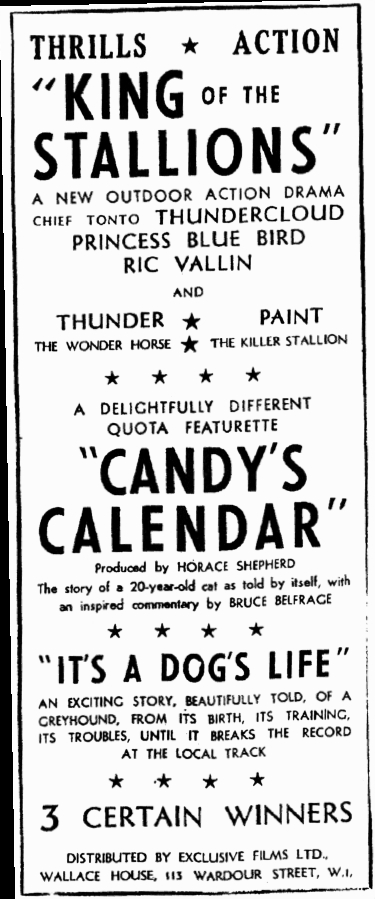
An import and two Hammer shorts.
1959 Ticket to Happiness
Operation Universe (DIR: Peter Bryan/Color/ Scope)
1961 O Hara’s Holiday (DIR: Peter Bryan/ Color)
Highway Holiday
Land of the Leprechauns
Modern Ireland
National Sporting Club
Released January, 1936 (U.K.); 23 minutes; 2200 feet; B & W; a W.H. Films Production; an Exclusive Film Release (U.K.); Director/Screenplay: George Mozart; Producer: Will Hammer.
George Mozart (Jack), Will Hammer (Bill), Apri Vivian (Polly), Pat Aherne (Fred), Ian Wilson (Lord Stockridge).
Jack (George Mozart) and Bill (Will Hammer) are two down on their luck fishermen. About to be evicted, they are saved by Polly through her meager savings. She also saves Lord Stockbridge (Ian Wilson) from drowning and is amply rewarded by his parents.
Polly’s Two Fathers was trade shown at the Gaumont Theater on January 10, 1936. Today’s Cinema (January 13) felt that it “provides an adequate background to the stagy treatment.”
35 minutes; 3243 feet; B & W; a Knightsbridge-Hammer Production; an Exclusive Release (U.K.); Director: Ben R. Hart; Producer: Hal Wilson; Screenplay: James Corbett.
John Blythe (Reporter), George Dewhurst (Inspector), Stan Paskin (Taxi Driver), Jackie Brent (Girl), Van Boolen (Crook), Agnes Brantford (Landlady).
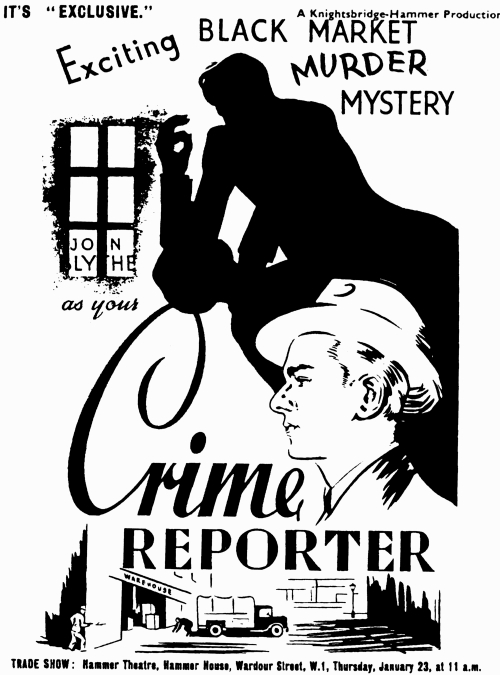
A “sincerely made” Hammer short.
A reporter (John Blythe) investigates the murder of a taxi driver and brings a gang of black-marketeers to justice.
The story was based on an actual incident that happened in the early 1940s. Crime Reporter was previewed with Skiffy Goes to Sea on January 23. The Kinematograph Weekly (January 24) found the picture “unpretentious, but by no means unexciting”; and Today’s Cinema (January 24) felt it had a “sincerity of purpose and clarity in design that emphasized the story values.”
36 minutes; 3205 feet; B & W; a W.W. British–Exclusive Film Production; an Exclusive Release (U.K.); Director, Producer: Walter West.
John Latham (Gray), Arthur Dibbs (Henry VIII), Valerie Carlish (Anne Boleyn). With: Stephen Philpott, G.W. Shelton.
This short was comprised of a trio of ghost stories followed by a discussion on their possible existence. It was filmed entirely on location at Hampton Court, Woodcraft Manor, and the Tower of London. A trade show was held at the Hammer Theater on March 6, 1947, and Today’s Cinema (March 11) found it to be a “crude recitation of three historic ghost stories. Poor direction, wooden portrayals, fair photography.”
35 minutes; B & W; 3100 feet.; a G.B. Instructional–Exclusive Film Production; an Exclusive Release (U.K.); Director: Darrell Catling.
Ingrid Forrest, Constance Smith, Gordon McLeod.
Two dress designers (Ingrid Forrest, Constance Smith) vie for fame and fortune in the clothing business, but after finding success, abandon their careers for marriage.
Material Evidence was trade shown in January, 1948, and The Kinematograph Weekly (April 8) found it “A documentary with a story, it’ll easily blend with most programs.”
36 minutes; 3306 feet; B & W; an Exclusive Film Production; an Exclusive Release (U.K.); Director, Screenplay: Richard Fisher.
Joyce Cummings (Irene Benentt), Michael Hawley (John Boulton).
In Birmingham, a reporter (Irene Bennett) saves a bus conductor (John Boulton) from crooks. The Kinematograph Weekly (December 23, 1948) called it “A silly crime story, badly acted and indifferently directed.”
25 minutes; 2512 feet; a Motley–Exclusive Film Production; an Exclusive Release (U.K.); Director, Screenplay: John Lamont; Producer: Norman Williams.
Phillip Saville (Markheim), Arthur Lowe (Arthur Henry), Ruth Sheil (Maid), Lloyd Lamble (Kelly), Christopher Lee (Visitant), Marius Goring (Narrator).
Markheim (Phillip Saville), an immoral young man, plans to rob and kill a shopkeeper. However, after a “mirror figure” (Christopher Lee) shows him his fate if he commits the crime, Markheim changes his mind.
Based on Robert Louis Stevenson’s short story, this picture was Christopher Lee’s first association with Hammer/Exclusive, and may have played some part in his being cast in The Curse of Frankenstein. A trade show was held on January 14, 1955, and The Kinematograph Weekly (January 20) felt “The acting is true to the stiff late nineties’ period, the detail is convincing, and the twist ending effective.”
1192 feet; B & W; an Exclusive Film Production; an Exclusive Film Release (U.K.).
An underdeveloped young man is left by his girlfriend for a muscleman. He takes a body building course, but gives it up after winning a fortune. His girl returns, more attracted to money than muscle. The short was trade shown on January 28, 1955, and Today’s Cinema (February 2) found it “very good and amusing.”
22 minutes; 2377 feet; Eastman Color; Hammerscope; a Hammer Film Production; an Exclusive Release (U.K.); filmed at Bray Studios; Director: David Paltenghi; Producer: Michael Carreras; Screenplay: Joel Murcott; Director of Photography: Stephen Dade; Editor: James Needs: Art Director: Ted Marshall; Production Manager: Jimmy Sangster.
Philip Friend (Dick Turpin/Palmer), Diane Hart (Liz), Alan Cuthbertson (Jonathan Redgrove), Gabrielle May (Genevieve), Hal Osmond (Mac), Raymond Rollett (Hawkins), Norman Mitchell (Rooks), John McDonald (Stableboy), George Mossman (Coachman), Barry DuBoulay, Ivor Collins (Ruffians), D. Thomas (Lord Wembley), Terry Yorke (Double for Turpin), Tom Yeardye (Double for Rooks).
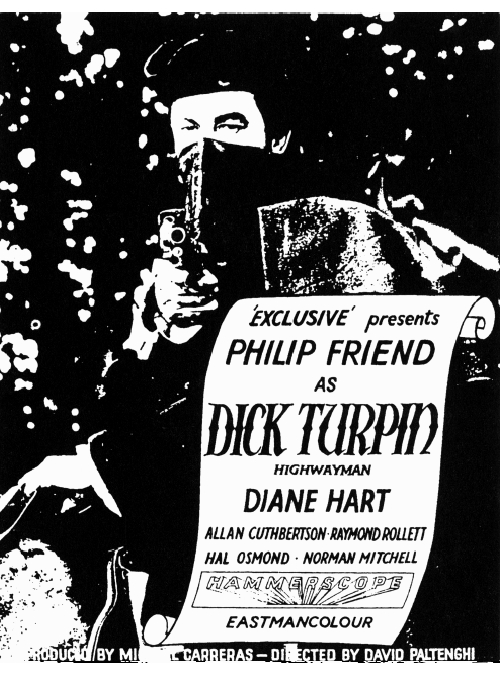
Dick Turpin Rides Again!
Jonathan Redgrave (Alan Cuthbertson), after collecting his bride’s dowry, is robbed by Dick Turpin (Philip Friend), a notorious highwayman. When Redgrave later refuses to marry Genevieve (Gabrielle May) due to the lost gold, Turpin determines that he was only interested in the loot. The bandit, for reasons of his own, foils Redgrave’s plan by forcing him to marry the girl and abandon his band of gold thieves.
Hammer’s fictionalization of the real-life robber (1706–1739) was trade shown in late December, 1956. The Kinematograph Weekly (January 3, 1957) enjoyed Philip Friend’s “appropriate swagger,” and felt that the chases were “expertly timed.”
29 minutes; 2606 feet; Eastman Color; a Hammer Film Production; an Exclusive Release (U.K.); Director: Joseph Losey; Producer: Anthony Hinds; Screenplay: Jimmy Sangster, based on the story “Chance at the Wheel” by Victor Canning; Director of Photography: Wilkie Cooper; Editor: Henry Richardson; Art Director: Edward Marshall; Music: John Hotchkis.
Michael Medwin (Max), Donald Wolfit (Dr. Carter), Michael Ripper (Chauffeur), Edward Forsyth (Clement), Alex de Gallier (Casino Manager).
“Lady M,” apparently a member of British high society, surprises a casino manager (Alex de Gallier) by knocking him out with a pistol and robbing him. Later, in a chauffeur (Michael Ripper) driven Rolls Royce, “she” removes “her” wig and makeup to reveal Max (Michael Medwin). Max plans to keep all of the money and, after a fierce struggle, stuffs the chauffeur’s body in the Rolls’ trunk and pushes it over a cliff. Suffering from a shoulder wound, Max passes out from the loss of blood. When he wakes up, he finds footprints leading away from where he lay, and follows them to a cottage on the beach. Carter (Donald Wolfit), the owner, is an odd man who is seemingly unconcerned by the pistol Max is constantly waving. After cleaning his wound with alcohol, Max faints again and, when he awakens, his shoulder is professionally bandaged. Max confesses his crime to Carter, who he now realizes is a doctor. When Sgt. Clement (Edward Forsyth) arrives later to take Carter fishing, Max tries to shoot him through the window, but the doctor disarms him. As Clement enters the home, Max is stunned to learn that Carter is blind.
Jimmy Sangster recalled in Little Shoppe of Horrors that he “just sort of fell into writing it. I remember sitting around the office one day, and Mike (Carreras) came up with a story idea and someone said, ‘why don’t you write it!’” Blacklisted Joseph Losey, who would later direct The Damned for the company, was in need of work and accepted a short after years of making acclaimed feature films. He said in Conversations with Losey that he was “amused with a transvestite disguise escape” and with the opportunity to experiment with color. The Kinematograph Weekly (April 19, 1956) called A Man on the Beach “an absorbing and entertaining oracle.”
Released January 9, 1956; 30 minutes; 2726 feet; CinemaScope; Eastman Color; a Hammer Film Production; an Exclusive Release (U.K.); Director: Peter Coles; Producer: Michael Carreras; Associate Producer: Mickey Delamar; Screenplay: Philip Mackie, based on his story; Music: Eric Winstone; Conducted by: John Hollingsworth; Director of Photography: Walter Harvey, B.S.C.; Editor: Spencer Reeve; Sound: RCA; Sound Recordists: Bill Sweeney, York Scarlet.
Margo Loren (Martha Jorgensen), Douglas Wilmer, David Markham.
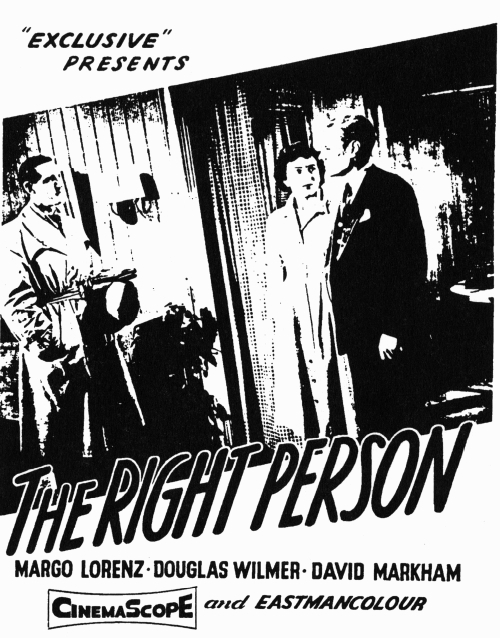
The Right Person, but the wrong approach.
While honeymooning in Copenhagen, Martha Jorgensen (Margo Loren) is visited by Mr. Rasmussen while her husband is out. He claims that he and Jorgensen were the only survivors of a Resistance group betrayed to the Nazis by a traitor with the code name “Toralf.” Martha gradually realizes that Rasmussen suspects her husband of being “Toralf,” and has come to murder him. When Jorgensen arrives at the hotel, Rasmussen studies him closely and decides he is not the traitor who caused a dozen deaths and made off with one hundred thousand kroner.
Jorgensen and Martha decide to celebrate, and he spends a large amount of money which, he claims, he inherited. The estate is worth £5,000—equal to one hundred thousand kroner.
The Kinematograph Weekly (December 8, 1955) was not impressed. “Although the players meet all demands, no attempt is made to break up the talk. Wordy and inconclusive, it’s more suited to TV than the silver screen.”
16 minutes; 1428 feet; Eastman Color; CinemaScope; a Hammer Film Production; an Exclusive Film Release (U.K.); Director/Producer: Michael Carreras; Director of Photography: Len Harris; Editor: Bill Lenny; Music: Eric Winstone.
Tom Conway (Narrator).
Michael Carreras not only produced and directed this travelogue, but appeared in it with his son Christopher. Len Harris recalled for the authors (December, 1993),
This was filmed on so low a budget that you wouldn’t believe it! We went to Copenhagen originally to film some backgrounds for a short called The Right Person. Michael Carreras, Harry Oakes, and me. Before we came home, Michael said, “Let’s make a documentary while we’re here.” We used the short ends of unused film from The Right Person. I actually directed most of it, not that much was required for a film like this. Michael was always off checking locations and getting permits. We had no script—just guidebooks. When we finally got to the city’s famous statue of the mermaid, it was all boarded up! It was being cleaned. We were only there a few days—there’d be no coming back tomorrow. I thought we might have been able to shoot a poster of it at Bray and use it as an insert, but it didn’t work out. So our film lacked the city’s most obvious monument. Everyone who saw the picture that knew me was “kind” enough to point that out! We were so low on film that every shot was held for a shorter duration than it warranted. Back at Bray, we extended each shot in the lab by repeating the last frame. This gave Tom Conway enough time to talk! All things considered, it’s an entertaining little film.
Kinematograph Weekly (August 16, 1956) called Copenhagen “entertaining and informative.”
22 minutes; 2037 feet; B & W; a Hammer Film Production; an Exclusive Film Release (U.K.); Director: Leslie Arliss; Producer: Anthony Hinds; Associate Producer: Anthony Nelson-Keys; Executive Producer: Michael Carreras; Director of Photography: Arthur Grant; Screenplay: J.D. Scott; Sound Recordist: W.H.P May; Art Director: Ted Marshall; Supervising Editor: James Needs; Editor: A.E. Cox.
Philip Friend (Dr. Jim Bennett), Honor Blackman (Gillian Freeman), Mervyn Johns (Mr. Ellis), Constance Fraser (Mrs. Ellis), Alexander Field (Mr. Carlton), Muriel Zillah (Mrs. Coombe), Amanda Coxell (Laura Coombe), Evelyn Gregg (Neighbor), Pauline Olsen (Young Nurse), Jeremy Longhurst (Mobile Policeman), Patricia Cree (Audrey), David Browning (Policeman), George Hirste (Postman).
During a routine check of her patients, Nurse Gillian Freeman (Honor Blackman) discovers that her assistant (Pauline Olsen) may have given one of three outpatients—Mr. Carlton (Alexander Field), Mrs. Ellis (Constance Fraser), and young Laura Coombe (Amanda Coxell)—a fatal drug instead of their medication. She contacts Dr. Bennett (Philip Friend) who alerts the police. Mr. Carlton is stopped moments before taking his pills, and Laura was prevented from taking hers due to a faulty water tap. Bennett and Freeman arrive at the Ellis home and find that Mr. Ellis (Mervyn Johns) has already given his wife the deadly pills. After her death, he admits that he took the remainder himself.
Released June, 1957; 26 minutes; 2430 feet; Eastman Color; Hammerscope; a Hammer Film Production; an Exclusive Release (U.K.); Director/Producer: Francis Searle; Screenplay: John Manchip White, Francis Searle; Director of Photography: Denny Densham; Editors: Bill Lenny, Stanley Smith; Art Director: Bernard Robinson; Production Manager: Tom Connochie; Assistant Director: Stanley Goulder; Sound Recordist: Cliff Sandell.
Vincent Winter (Ian), John Lawrie (Uncle Henry), Grace Arnold (Aunt Helen), George Woodbridge (Mr. Kemp), Nora Gordon (Mrs. Kemp), David Grahame (Poacher), Jeanne of Bothkennar (Dan).
Young Ian’s (Vincent Winter) only friend is Dan, his aging sheepdog. But after Dan causes an accident that nearly kills Ian, the boy’s Uncle Henry (John Lawrie) determines to destroy the animal. He hires a poacher (David Grahame) to kill Dan, but Ian and the dog run off. They are found in his barn by Kemp (George Woodbridge), who suggests a plan to save Dan. He will pay Ian to help him on his farm, but the money will go to Henry to pay for Dan’s keep. Ashamed of his harsh behavior, Henry agrees.
The Kinematograph Weekly (June 13, 1957) was impressed, calling it “admirably suited to child audiences.” The story was praised as being “handled with sympathy,” and Vincent Winter’s performance was hailed as having “unusual merit.”
20 minutes; 1865 feet; a Hammer Film Production; an Exclusive Release (U.K.); Director: Leslie Arliss; Producer: Anthony Hinds; Executive Producer: Michael Carreras; Associate Producer: Anthony Nelson-Keys; Director of Photography: Arthur Grant; Editors: James Needs, A.E. Cox; Art Director: Ted Marshall; Production Manager: Don Weeks; Sound Recordist: W.H.P. May.
Clifford Evans (Dr. Bennett), Maurice Denham (Mr. Keeble), Sarah Lawson (Vicky Alexandra), John Van Eyssen (Dr. Langham), Marianne Stone (Mrs. Stephens), Jan Holden (Nurse), Margaret Boyd (Mrs. Tidmarsh), Malcolm Knight (Bert), Anthony Ford (Alf), Andrew Mott-Harrison (Giles), Clive Marshall (Jim).
Mr. Keeble (Maurice Denham), an aging war veteran with a painful leg ailment, is told by Dr. Bennett (Clifford Evans) that he must have an immediate operation. Keeble refuses because he does not want to be parted from his dog Lancelot and his fish—the lonely man’s only companions. Vicky (Sarah Lawson), a hospital volunteer, persuades Keeble that if he agrees to the surgery, she will see to it that his pets are wellcared for. As he is being wheeled into the operating room, he meets the children who will feed the dog and run his newspaper stand. The biggest surprise is that the unsentimental Dr. Bennett has volunteered to care for the fish.
Man with a Dog was filmed at Bray from March 25 to 29, 1957. The Kinematograph Weekly found the short “reminiscent of the TV Emergency Ward 10 series, quite well acted and staged.”
Released May 26, 1958; 2581 feet; 29 minutes; a Hammer Film Production; Director: Maclean Rogers; Producer: Anthony Hinds; Associate Producer: Anthony Nelson-Keys; Executive Producer: Michael Carreras; Director of Photography: Arthur Grant; Production Manager: Don Weeks; Sound Recordist: W.H.P. May; Art Director: Ted Marshall; Supervising Editor: James Needs; Editor: A.E. Cox.
Eric Barker (George Watson), Thora Hird (Vera Watson), Vera Day (Beryl Watson), Ian Whittaker (Dick Watson), Wallas Eaton (Ted), Bill Fraser (Bookmaker).
George Watson’s (Eric Barker) idyllic family life is shattered when his wife Vera (Thora Hird) discovers that he has begun to gamble again. She banishes him to the spare room and refuses to cook for him. They communicate through messages carried by their children (who also smuggle meals to him). When George wins a small fortune on the sweepstakes, he and Vera are united. Their joy is short-lived, however—his ticket is disputed by the judges. They relent, and with his winnings, George buys a partnership in a bookmaking business.